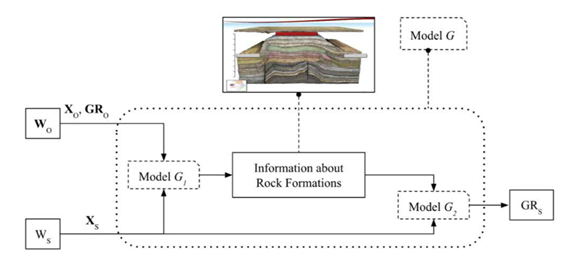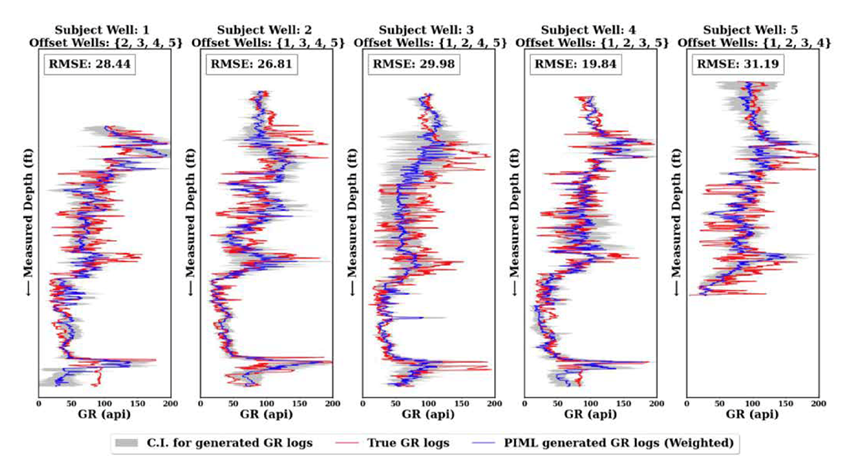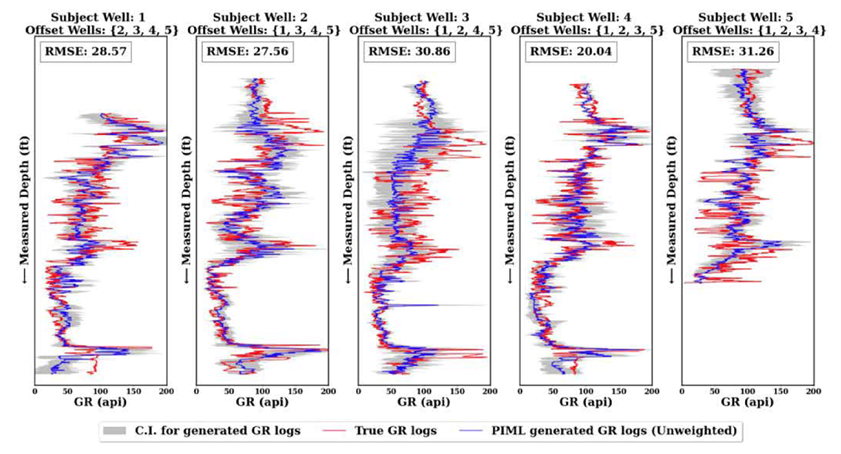Revolutionizing well logging: Generating real-time gamma ray logs from drilling data with physics-informed machine learning
Introduction
The oil and gas industry is in constant pursuit of innovation, seeking ways to optimize exploration, production, and, ultimately, profitability. A critical aspect of this optimization lies in understanding the subsurface environment, where valuable resources are locked away. Logging while drilling (LWD) has emerged as a cornerstone technology, providing real-time data about subsurface formations as drilling progresses. However, traditional LWD methods, while effective, rely on deploying sophisticated and expensive tools downhole. These tools, often susceptible to harsh downhole conditions, contribute significantly to the overall cost of drilling operations.
In this article, we delve into a novel approach to generating formation evaluation logs—specifically gamma ray (GR) logs—in real time, leveraging the power of physics-informed machine learning (PIML). This method uses data from nearby wells (offset wells) and readily available real-time drilling parameters to computationally generate GR logs, potentially revolutionizing well logging operations and paving the way for a more cost-effective and efficient future.
The Challenge: Costly Logging Tools and the Need for Real-Time Insights
Traditional LWD methods, while indispensable for characterizing subsurface formations, come with inherent challenges:
- High Costs: Deploying specialized logging tools downhole represents a significant portion of overall drilling expenses. These tools are not only expensive to acquire but also require careful handling and maintenance, further adding to the cost.
- Tool Failure Risks: The harsh downhole environment, characterized by extreme temperatures and pressures, poses a constant risk of tool failure. A malfunctioning tool can lead to costly downtime and compromise the quality of data acquired.
- Limited Real-Time Insights: While some LWD tools provide real-time data, the complexity of analysis often delays critical decision-making. Having access to real-time formation evaluation logs could significantly enhance drilling optimization.
These challenges underscore the need for innovative solutions that can provide accurate and timely subsurface information while reducing reliance on expensive and failure-prone downhole tools. This is where PIML emerges as a game-changer.
PIML: Bridging the Gap Between Physics and Machine Learning
PIML represents a paradigm shift in data analysis. Unlike purely data-driven machine-learning approaches, which rely solely on identifying patterns within data, PIML incorporates domain-specific physics into the learning process. This integration of physics offers several advantages:
- Enhanced Accuracy: PIML models are better equipped to generalize to unseen data and make more accurate predictions by incorporating known physical laws and constraints.
- Improved Interpretability: PIML models provide insights into the underlying physical processes, making the results more interpretable and trustworthy.
- Reduced Data Dependency: PIML models often achieve high accuracy with less training data, as the incorporated physics provides valuable prior information.
PIML also allows us to bring to bear our unique multi-decade knowledge of the physical phenomena and operations in this process, allowing us to build a robust solution compared to a pure data-analytics approach. Such a solution that leverages our domain understanding reduces the barrier to entry for operational use and also enables the verification and validation of such a solution in a strict systems engineering sense.
In the context of GR log generation, the newly proposed PIML approach leverages the known relationships between drilling parameters, rock formations, and GR log responses to build a robust and accurate model. This model, trained on data from offset wells, can predict GR logs for new wells in real time using only readily available drilling parameters.
Deconstructing the PIML Framework for GR Log Generation
The PIML framework presented in the research paper comprises three interconnected stages, each designed to extract meaningful information and build upon the previous stage's output:
Stage 1: Extracting Formation Information - Unraveling the Subsurface Puzzle
The first stage focuses on identifying formation tops, which are the boundaries between different rock layers. This information is crucial for understanding the geological context and interpreting GR log responses. The framework employs a two-step process to extract this information:
- Automated Formation Extraction using Clustering: The framework employs a time-series clustering technique to group similar segments of GR logs from offset wells. This approach is analogous to how geologists visually identify formations based on patterns in GR logs.
- Incorporating Prior Geological Knowledge: To enhance the robustness of the model, the framework allows for the incorporation of prior geological information about the region, such as known formation depths and lithologies. This prior information is integrated using probabilistic labels, which capture the uncertainty associated with both the algorithmic predictions and the prior knowledge.
Stage 2: Generating GR Logs from Physics and Empirical Models - A Two-Pronged Approach
The second stage focuses on predicting GR logs using two distinct models, each capturing different aspects of the relationship between drilling parameters, formations, and GR log responses:
- The Physics Model: Leveraging Trajectory-Based Averages: This model exploits the correlation between well trajectories and GR log responses. It computes the average GR log values across offset wells at each depth point, considering the well's trajectory. This approach assumes that wells drilling through similar formations at similar depths will exhibit similar GR log responses.
- The Empirical Model: Data-Driven Statistical Insights: This model relies on statistical methods to capture the empirical relationships between drilling parameters and GR log responses. It utilizes a distance-based weighting approach, where the GR log value at a given depth point in the subject well is estimated based on the weighted average of GR log values from nearby depth points in offset wells.
Stage 3: Formation Classification and Regression - Refining the Predictions
The final stage combines the outputs from the previous stages to generate the final GR log prediction. It uses a two-step process:
- Formation Classification: The framework utilizes a classification model to predict the most likely formation class at each depth point in the subject well. This classification is based on the extracted formation information from stage 1 and the estimated GR log values from stage 2.
- Formation-Based Regression: Once the formation class is predicted, a separate regression model, specifically trained for that formation class, is used to generate the final GR log value at that depth point. This approach ensures that the final prediction incorporates both the formation information and the specific GR log characteristics for that formation.
The framework offers two options for generating the final GR log:
- Unweighted GR Log Estimation: This approach directly uses the GR log value predicted by the regression model for the most likely formation class at each depth point.
- Weighted GR Log Estimation: This approach takes a more nuanced approach, considering the probabilities of all possible formation classes at each depth point. It calculates a weighted average of the GR log values predicted by the regression models for all possible formation classes, with weights determined by the respective probabilities.

Figure 1: Workflow for multi-staged decomposed framework. Model G1 (representing the former stages) extracts the latent information for the formation using the drilling parameters, and Model G2 (representing the latter stages) uses the extracted rock formation information obtained through Model along with the drilling measurements to generate the GR logs.
Putting PIML to the Test: Experimental Validation and Results
We validated the PIML framework using real-world data from five US Land Permian Basin wells. The data included both surface drilling parameters and GR log measurements. A leave-one-out cross-validation approach was employed, where each well was treated as the subject well once, and the remaining four wells served as offset wells. This rigorous validation methodology assessed the model's performance across various scenarios.
The results demonstrated the remarkable accuracy of the PIML framework in predicting GR logs. The average RMSE across all five wells was 27.25 API, representing an error of approximately 10%. This accuracy level is particularly impressive given that the model relies solely on readily available drilling parameters and data from offset wells, eliminating the need for costly downhole logging tools.
Visualizing the Results: A Closer Look at the Performance
We provide detailed visualizations of the PIML framework's performance. These visualizations, presented as plots comparing the predicted GR logs with the actual GR logs for each well, highlight the model's ability to capture the trends and patterns in the data accurately.
The visualizations also demonstrate the value of the weighted GR log estimation approach. The weighted approach, by considering the probabilities of all possible formations, generates smoother and more reliable GR log predictions compared to the unweighted approach, which can be more susceptible to noise and uncertainty.

Figure 2: Leave-one-out validation results for different wells. The red solid line represents the ground truth recorded GR logs from the wells. The blue solid line represents the computationally generated GR logs (weighted). The gray shaded region represents the confidence interval for the computationally generated GR logs.

Figure 3: Leave-one-out validation results for different wells. The red solid line represents the ground truth recorded GR logs from the well. The blue solid line represents the computationally generated GR (unweighted) logs. The gray shaded region represents the confidence interval for the computationally generated GR logs.
Beyond GR Logs: Extending the Framework for Broader Applications
While this research focused explicitly on generating GR logs, the underlying PIML framework can be adapted to predict other formation evaluation logs, such as density, porosity, and sonic logs. This adaptability stems from the framework's modular design, where different modules can be plugged in or modified depending on the specific application.
The future of formation evaluation lies in harnessing the power of data-driven approaches like PIML. By integrating physics-based knowledge with advanced machine-learning algorithms, we can unlock new possibilities for characterizing the subsurface, optimizing drilling operations, and, ultimately, enhancing the efficiency and cost-effectiveness of oil and gas exploration and production.
Conclusion: Ushering in a New Era of Well Logging with PIML
This article presents a compelling case for the transformative potential of PIML in the field of well logging. By enabling the generation of real-time formation evaluation logs from readily available drilling parameters, PIML offers a pathway to:
- Significant Cost Savings: Reducing reliance on expensive and failure-prone downhole logging tools can translate into substantial cost reductions for drilling operations.
- Enhanced Drilling Efficiency: Real-time access to formation evaluation logs can empower drillers to make informed decisions on the fly, optimizing drilling parameters and reducing non-productive time.
- Improved Reservoir Characterization: The ability to generate accurate formation evaluation logs from readily available data can enhance our understanding of the subsurface, leading to better reservoir models and more efficient resource extraction.
As the oil and gas industry continues to embrace digitalization and data-driven approaches, PIML is poised to play an increasingly crucial role in unlocking the full potential of subsurface resources. The technology we have developed and presented here marks a significant step in this direction, paving the way for a future where well logging is smarter, faster, and more cost effective than ever before.
Reference
Sheth, P., Sistla, S., Roychoudhury, I., Gao, M., Chatar, C., Celaya, J., & Mishra, P. "Real-Time Gamma Ray Log Generation from Drilling Parameters of Offset Wells Using Physics-Informed Machine Learning." SPE Journal (2024) Vol, 1350-1360.